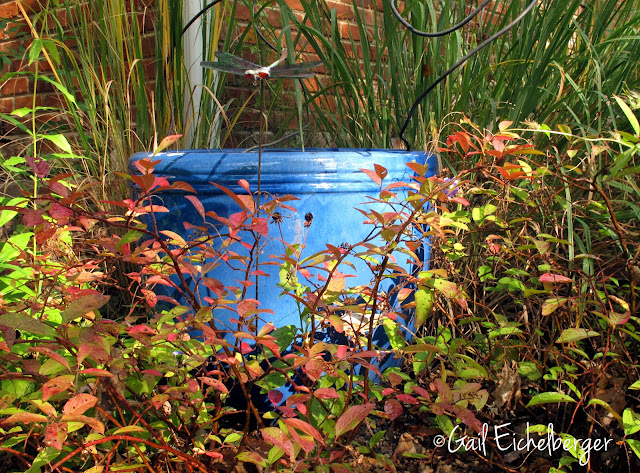 |
| Plants are pollen rich, but have no nectar! |
I'm puzzled that it's not offered in better gardening centers, but, I'm always puzzled that the same old same old bread and butter shrubs are sold all over this part of the gardening world. Especially when you compare the merits of a Burning Bush to all that Cedarglade St. Johnswort has to offer.
You want fiery reds~You got it!
Or, burgundy and orange~It delivers.
How about golden leaves with just a touch of rose that looks stunning next to a bright colored bench!
 |
| In Middle Tennessee it is endemic to woodlands adjacent to cedar glades |
This plant propagates so easily from seed or stem cuttings that no one can convince me that it is not commercially viable.
 |
| Mid November 2012 |
I have dozens of Golden St John's wort shrubs in my garden now. All the offspring of one Hypericum frondosum 'Sunburst' cultivar that I bought fifteen years ago. Yes, I said dozens! It's a shrub that thinks it's a perennial and a few seedlings pop up near the mother plant each spring. I have moved them all over the garden and every one is covered in golden flowers that attract pollinators, just like its cultivar parent. They're planted in full sun, shade, dry soil and soil that's wet all winter. It looks best and is happiest planted among shrubs that might be found in a woodlands adjacent to a cedar glade~Juniperus virginiana 'Gray Owl', Panicum virgatum, the native ex-asters, Chasmanthium latifolium, Phlox pilosa, Penstemon calycosus, Christmas Ferns and more.
I love its hyper-colored fall display,
the exfoliating bark,
the blue green summer foliage, and
the pollinator magnet golden sunburst flowers.
 |
| Golden foliage with red seed capsules |
xxoogail
* Native from South Carolina and Tennessee south to southern Georgia and west to eastern Texas, Zones 5-8
Welcome to Clay and Limestone's Wildflower Wednesday celebration. WW is about sharing and celebrating wildflowers from all over this great big, beautiful world. Join us on the fourth Wednesday of each month. Remember, it doesn't matter if they are in bloom or not and, it doesn't matter if we all share the same plants. It's all about celebrating wildflowers. Please leave a comment when you add your url to Mr Linky.
Gail Eichelberger is a gardener and therapist in Middle Tennessee. She loves wildflowers and native plants and thoroughly enjoys writing about the ones she grows at Clay and Limestone. She reminds all that the words and images are the property of the author and cannot be used without written permission.






































